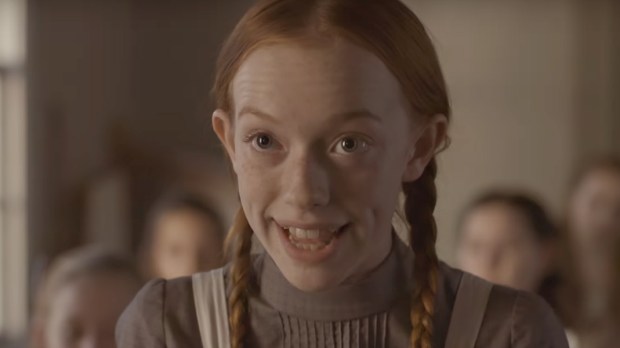Netflix recently premiered Anne With an E, an adaptation of Anne of Green Gables, which was written by L.M. Montgomery in 1908 to great popularity. The reviews are in, and, well, let’s just say the Netflix version is a bigger misstep than that time Anne accidentally gave Diana three tumblerfuls of currant wine. The familiar stories are there, but now instead of being lighthearted they’re draped in darkness and adult themes. For instance, instead of being content with hinting at Anne’s past troubles as the book does, Anne With an E depicts her past in an over-the-top, graphic portrayal of physical abuse of the sort that casts a pall over every subsequent event in Anne’s life. At Vanity Fair, Joanna Robinson writes that it’s “a gloomy series with grim, life-or-death stakes draped over the bones of something beloved, warm-hearted, and familiar.” Lauren Hanson at The Federalist remarks that this version of Anne is “Less romantic dreamer and more PTSD survivor on the verge of a mental break.”

Read more:
How I managed to unplug my kids
In short, Anne With an E seems to have been created on the premise that the beloved classic isn’t mature or gritty enough, but the original Anne of Green Gables is a classic for a reason. Perhaps it’s time to remind ourselves of why we all love her so much.
Everybody is important
Anne Shirley wasn’t supposed to show up in Avonlea. Marilla and Matthew Cuthbert wanted to adopt a boy to help out around their farm, but through a misunderstanding the orphanage sent Anne instead. Not only is she a girl when a boy was expected, she’s also a chatterbox who dislikes her distinct red hair and has a penchant for getting into trouble. Anne may not be the person who was expected or even wanted, but as Marilla ends up realizing: “We needed her.”
Anne of Green Gables isn’t only about Anne, either. It’s a study in how every single person is important, how everyone leaves a mark, and no one is too insignificant to contribute to a family or community. In fact, our communities are stronger the more inclusive and diverse they are. My friend Catherine, a dedicated Anne fan, says, “L.M. Montgomery developed all of her characters — big, small, good guy, bad guy. NO ONE stays the same, even those you just pass by. Her understanding and communication of humanity is honest, respectful, nuanced … a very beautiful thing.”
As Anne puts is so well, “Kindred spirits are not so scarce as I used to think. It’s splendid to find out there are so many of them in the world.”
True-to-life coming of age story
Not everyone knows that Anne of Green Gables is a whole set of books that follows her life past childhood. If you read them all you’ll encounter the story of a young girl as she matures into a feminine, graceful adult. She struggles with real, actual problems that all girls and young women deal with.
For instance, her innocence about the world suits her well as a small child. She can exclaim how much she loves Octobers, fashionable clothes, and the smell of roses all she wants, but if she still talks so much and expresses herself so freely as an adult, her childish imagination might not age so well. Anne herself realizes this, saying, “I don’t know, I don’t want to talk as much. (…) It’s nicer to think dear, pretty thoughts and keep them in one’s heart, like treasures. I don’t like to have them laughed at or wondered over.”
Part of the maturing process is also a bit of disappointment with the realization that not all dreams come true. Although we should always dream, those dreams are eventually tempered by realistic expectations. Anne opines, “That’s the worst of growing up, and I’m beginning to realize it. The things you wanted so much when you were a child don’t seem half so wonderful to you when you get them.” As we age, our goals and priorities change. This can be stressful (ask any teenager) and might involve some disappointment, but we must face adulthood head-on as we mature. What we leave behind might not be half so wonderful as what lies ahead.
A realistic (and tender) romance
Gilbert Blythe is a handsome, self-assured young man when he first encounters Anne. He’s immediately smitten and, as all young men do, finds a way to tease his crush, referring to her as “Carrots.” Teasing is, as all young men also discover, exactly the wrong way to attract a young lady. Anne quickly dismisses him.
Such begins a great romance. This is no over-heated Hollywood love story, though – it’s much better. Gilbert and Anne is the sort of realistic relationship we can all dream about, a young man who is made better by his love of a woman, who matures into a steady, dependable husband that all women deserve. Their love proceeds in fits and starts, first with rejection, then romance, maturation, and finally, family. Gilbert holds Anne when they lose their first baby, cherishes her without objectifying her, and is sensitive to her needs while still retaining his role as head of the family. Their love is a great example for all of us who are in love or looking for love about what a relationship saturated with grace really looks like.
Respect for the seriousness of childhood
Anne is a child, yes, but her emotions and thoughts are nevertheless valuable. We don’t need to be adults before our lives have meaning, and a book doesn’t need to focus only on so-called “adult themes” to be taken seriously. A book can be innocent and profound at the same time. In fact, a story that respects childhood and coming-of-age without sensationalizing it is much closer to the real-life struggles and joys that we face in our own lives. I asked Charlie, a friend of mine, why he loves Anne of Green Gables so much. “Because it is a story focusing on people, their values, and how their character and values affect their relationships — and how people can change, forgive, and grow,” he answered.
Learning to change, forgive, and grow is precisely the task of any maturing child (and probably we adults ought to keep at it, too). Anne finds herself in all sorts of oddball predicaments and teaching moments as she stumbles towards adulthood, but these situations are serious even while they’re amusing. I remember how upset I was when as a boy I broke my neighbor’s window with a soccer ball and had to ring her doorbell, apologize, and pay a whole week of allowance to buy a new one. Now that I’m an adult, seemingly insignificant events can still have a big effect, and this is as it should be, because what are we here for if it isn’t to keep growing and striving in everyday life? Big changes begin in small ways.

